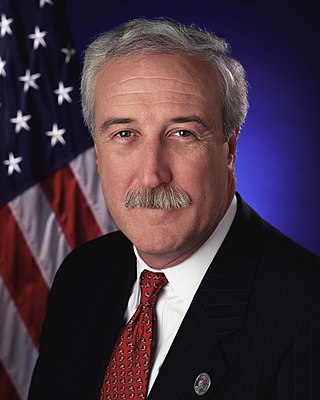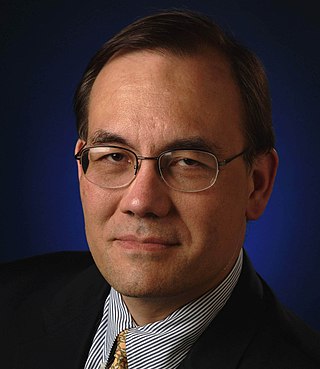Related Research Articles

The Jet Propulsion Laboratory (JPL) is a federally funded research and development center and NASA field center in the City of La Cañada Flintridge, California, United States.

The Discovery Program is a series of Solar System exploration missions funded by the US National Aeronautics and Space Administration (NASA) through its Planetary Missions Program Office. The cost of each mission is capped at a lower level than missions from NASA's New Frontiers or Flagship Programs. As a result, Discovery missions tend to be more focused on a specific scientific goal rather than serving a general purpose.

Sean Charles O'Keefe is a university professor at Syracuse University Maxwell School, former chairman of Airbus Group, Inc., former Secretary of the Navy, former Administrator of NASA, and former chancellor of Louisiana State University (LSU). He is a former member of the board of directors of DuPont.

James Edwin Webb was an American government official who served as Undersecretary of State from 1949 to 1952. He was the second Administrator of NASA from February 14, 1961, to October 7, 1968. Webb led NASA from the beginning of the Kennedy administration through the end of the Johnson administration, thus overseeing each of the critical first manned missions throughout the Mercury and Gemini programs until days before the launch of the first Apollo mission. He also dealt with the Apollo 1 fire.

The SETI Institute is a not-for-profit research organization incorporated in 1984 whose mission is to explore, understand, and explain the origin and nature of life in the universe, and to use this knowledge to inspire and guide present and future generations, sharing knowledge with the public, the press, and the government. SETI stands for the "search for extraterrestrial intelligence".

The Vision for Space Exploration (VSE) was a plan for space exploration announced on January 14, 2004 by President George W. Bush. It was conceived as a response to the Space Shuttle Columbia disaster, the state of human spaceflight at NASA, and as a way to regain public enthusiasm for space exploration.

The Maxwell School of Citizenship and Public Affairs is the professional public policy school of Syracuse University, a private research university in Syracuse, New York. The school is organized in 11 academic departments and 13 affiliated research centers and offers coursework in the fields of public administration, international relations, foreign policy, political Science, science and technology policy, social sciences, and economics through its undergraduate (BA) degrees, graduate Master of Public Affairs (MPA), Master of Arts (MA), and PhD degrees.
As a federal agency, the National Aeronautics and Space Administration (NASA) receives its funding from the annual federal budget passed by the United States Congress. The following charts detail the amount of federal funding allotted to NASA each year over its history to pursue programs in aeronautics research, robotic spaceflight, technology development, and human space exploration programs.
Wesley T. Huntress, Jr. is an American space scientist. An astrochemist and space scientist, Huntress worked for about twenty years at NASA's Jet Propulsion Laboratory. During the 1980s, he was also a video game designer, producing games for Apple computers. In 1988, Huntress moved to NASA headquarters, where he would serve in several positions, including Director of NASA's Solar System Exploration Division and Associate Administrator for Space Science.

The Space Exploration Initiative was a 1989–1993 space public policy initiative of the George H. W. Bush administration.
Space policy is the political decision-making process for, and application of, public policy of a state regarding spaceflight and uses of outer space, both for civilian and military purposes. International treaties, such as the 1967 Outer Space Treaty, attempt to maximize the peaceful uses of space and restrict the militarization of space.

The National Aeronautics and Space Administration is an independent agency of the U.S. federal government responsible for the civil space program, aeronautics research, and space research.

The National Space Council is a body within the Executive Office of the President of the United States created in 1989 during the George H. W. Bush administration, disbanded in 1993, and reestablished in June 2017 by the Donald Trump administration. It is a modified version of the earlier National Aeronautics and Space Council (1958–1973).

Scott Norman Pace currently serves as Director of the Space Policy Institute, Director of the Institute for International Science and Technology Policy and Director of the MA International Science and Technology Policy program at the George Washington University's Elliott School of International Affairs. He served as the Executive Secretary of the National Space Council from July 2017 to January 2021, when he resigned. Pace was formerly the Director of the Space Policy Institute at the Elliott School of International Affairs at George Washington University, where he was also a Professor of the Practice of International Affairs.

The Review of United States Human Space Flight Plans Committee, better known as the HSF Committee, Augustine Commission, or Augustine Committee, was a group convened by NASA at the request of the Office of Science and Technology Policy (OSTP), to review the nation's human spaceflight plans to ensure "a vigorous and sustainable path to achieving its boldest aspirations in space." The review was announced by the OSTP on May 7, 2009. It covered human spaceflight options after the time NASA had planned to retire the Space Shuttle. A summary report was provided to the OSTP Director John Holdren, White House Office of Science and Technology Policy (OSTP), and NASA Administrator on September 8, 2009. The estimated cost associated with the review was expected to be US$3 million. The committee was scheduled to be active for 180 days; the report was released on October 22, 2009.

The space policy of the Barack Obama administration was announced by U.S. President Barack Obama on April 15, 2010, at a major space policy speech at Kennedy Space Center. He committed to increasing NASA funding by $6 billion over five years and completing the design of a new heavy-lift launch vehicle by 2015 and to begin construction thereafter. He also predicted a U.S.-crewed orbital Mars mission by the mid-2030s, preceded by the Asteroid Redirect Mission by 2025. In response to concerns over job losses, Obama promised a $40 million effort to help Space Coast workers affected by the cancellation of the Space Shuttle program and Constellation program.

The space policy of the United States includes both the making of space policy through the legislative process, and the implementation of that policy in the United States' civilian and military space programs through regulatory agencies. The early history of United States space policy is linked to the US–Soviet Space Race of the 1960s, which gave way to the Space Shuttle program. At the moment, the US space policy is aimed at the exploration of the Moon and the subsequent colonization of Mars.

The Planetary Missions Program Office is a division of NASA headquartered at the Marshall Space Flight Center, formed by the agency's Science Mission Directorate (SMD). Succeeding the Discovery and New Frontiers Program Office, it was established in 2014 to manage the Discovery and New Frontiers programs of low and medium-cost missions by third-party institutions, and the Solar System Exploration program of NASA-led missions that focus on prioritized planetary science objectives. The Discovery and New Frontiers programs were established in 1992 and 2001 respectively, and have launched fourteen primary missions together, along with two missions launched under the administration of the Planetary Missions Program Office. The Solar System Exploration Program was established alongside the office, with three missions planned for launch under the new program.

The Artemis program is a robotic and human Moon exploration program led by the United States' National Aeronautics and Space Administration (NASA) along with three partner agencies: European Space Agency (ESA), Japan Aerospace Exploration Agency (JAXA), and Canadian Space Agency (CSA). The Artemis program intends to reestablish a human presence on the Moon for the first time since the Apollo 17 mission in 1972. The major components of the program are the Space Launch System (SLS), Orion spacecraft, Lunar Gateway space station and the commercial Human Landing Systems. The program's long-term goal is to establish a permanent base camp on the Moon and facilitate human missions to Mars.
References
- 1 2 Blanker, Julie, ed. (April 2005). "Alumni Notes:1961". Johns Hopkins Magazine. Retrieved 7 August 2021.
- ↑ Lambright, W. Henry (1966). NASA and the politics of patents: a study of administrative pluralism (PhD). Columbia University Libraries. OCLC 7018164 . Retrieved 7 August 2021.
- ↑ "Milestone Years of Service Recognition". SU News. May 7, 2021. Retrieved 7 August 2021.
- ↑ Launching a New Mission: Michael Griffin and NASA's Return to the Moon (Report). IBM Center for The Business of Government. 2009. p. 37. Retrieved 7 August 2021.
- 1 2 "NAPA: W. Henry Lambright MEMBER SINCE: 2012". National Academy of Public Administration. Retrieved 7 August 2021.
- 1 2 "NASA History Home Page". history.nasa.gov. NASA . Retrieved 7 August 2021.
- 1 2 Boyle, Rebecca (22 February 2017). "Americans Will Never Make Mars A Priority. Why Should That Stop Us?". FiveThirtyEight . Retrieved 7 August 2021.
- 1 2 Haley, Kathleen (September 29, 2015). "The Implications of Finding Water on Mars: Q&A with Professor W. Henry Lambright". SU News. Retrieved 7 August 2021.
- ↑ "Faculty Experts: W. Henry Lambright". SU News. Retrieved 7 August 2021.
- ↑ Plumer, Brad (26 April 2017). "A Cold War theory for why scientists and the government have become so estranged". Vox . Retrieved 7 August 2021.
- ↑ Borenstein, Seth (16 February 2012). "INFLUENCE GAME: Leaks show group's climate efforts". Boston.com . Retrieved 7 August 2021.
- ↑ Mariani, John (8 July 2011). "Space shuttle retirement prompts space veterans with Syracuse ties to ask, What's next?". Syracuse Post-Standard . Retrieved 7 August 2021.
- ↑ Borenstein, Seth (1 February 2012). "Experts say Gingrich moon base dreams not lunacy". The Seattle Times. Retrieved 7 August 2021.
- ↑ Borenstein, Seth (April 5, 2011). "Company planning biggest rocket since man on moon". Post and Courier. Retrieved 7 August 2021.
- ↑ 2004 AAAS Annual Report - American Association for the Advancement of Science (PDF). American Association for the Advancement of Science (Report). 2004. p. 21. Retrieved 7 August 2021.
- ↑ "W. Henry Lambright's New Book Explores NASA's Mars Program". SU News. July 16, 2014. Retrieved 7 August 2021.